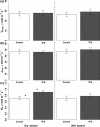After more than a decade of soil moisture deficit, tropical rainforest trees maintain photosynthetic capacity, despite increased leaf respiration
- PMID: 26179437
- PMCID: PMC4989466
- DOI: 10.1111/gcb.13035
After more than a decade of soil moisture deficit, tropical rainforest trees maintain photosynthetic capacity, despite increased leaf respiration
Abstract
Determining climate change feedbacks from tropical rainforests requires an understanding of how carbon gain through photosynthesis and loss through respiration will be altered. One of the key changes that tropical rainforests may experience under future climate change scenarios is reduced soil moisture availability. In this study we examine if and how both leaf photosynthesis and leaf dark respiration acclimate following more than 12 years of experimental soil moisture deficit, via a through-fall exclusion experiment (TFE) in an eastern Amazonian rainforest. We find that experimentally drought-stressed trees and taxa maintain the same maximum leaf photosynthetic capacity as trees in corresponding control forest, independent of their susceptibility to drought-induced mortality. We hypothesize that photosynthetic capacity is maintained across all treatments and taxa to take advantage of short-lived periods of high moisture availability, when stomatal conductance (gs ) and photosynthesis can increase rapidly, potentially compensating for reduced assimilate supply at other times. Average leaf dark respiration (Rd ) was elevated in the TFE-treated forest trees relative to the control by 28.2 ± 2.8% (mean ± one standard error). This mean Rd value was dominated by a 48.5 ± 3.6% increase in the Rd of drought-sensitive taxa, and likely reflects the need for additional metabolic support required for stress-related repair, and hydraulic or osmotic maintenance processes. Following soil moisture deficit that is maintained for several years, our data suggest that changes in respiration drive greater shifts in the canopy carbon balance, than changes in photosynthetic capacity.
Keywords: drought; leaf dark respiration; photosynthetic capacity; through-fall exclusion; tropical rainforest.
© 2015 John Wiley & Sons Ltd.
Figures





Similar articles
-
Limited stomatal regulation of the largest-size class of Dryobalanops aromatica in a Bornean tropical rainforest in response to artificial soil moisture reduction.J Plant Res. 2020 Mar;133(2):175-191. doi: 10.1007/s10265-019-01161-3. Epub 2019 Dec 19. J Plant Res. 2020. PMID: 31858360
-
Effects of rainfall exclusion on leaf gas exchange traits and osmotic adjustment in mature canopy trees of Dryobalanops aromatica (Dipterocarpaceae) in a Malaysian tropical rain forest.Tree Physiol. 2017 Oct 1;37(10):1301-1311. doi: 10.1093/treephys/tpx053. Tree Physiol. 2017. PMID: 28541561
-
Limited acclimation in leaf anatomy to experimental drought in tropical rainforest trees.Tree Physiol. 2016 Dec;36(12):1550-1561. doi: 10.1093/treephys/tpw078. Epub 2016 Sep 10. Tree Physiol. 2016. PMID: 27614360 Free PMC article.
-
Short-term effects of drought on tropical forest do not fully predict impacts of repeated or long-term drought: gas exchange versus growth.Philos Trans R Soc Lond B Biol Sci. 2018 Oct 8;373(1760):20170311. doi: 10.1098/rstb.2017.0311. Philos Trans R Soc Lond B Biol Sci. 2018. PMID: 30297468 Free PMC article. Review.
-
Drought responses of flood-tolerant trees in Amazonian floodplains.Ann Bot. 2010 Jan;105(1):129-39. doi: 10.1093/aob/mcp258. Ann Bot. 2010. PMID: 19880423 Free PMC article. Review.
Cited by
-
Convergence in Maximum Stomatal Conductance of C3 Woody Angiosperms in Natural Ecosystems Across Bioclimatic Zones.Front Plant Sci. 2019 May 7;10:558. doi: 10.3389/fpls.2019.00558. eCollection 2019. Front Plant Sci. 2019. PMID: 31134112 Free PMC article.
-
Long-term drought effects on the thermal sensitivity of Amazon forest trees.Plant Cell Environ. 2023 Jan;46(1):185-198. doi: 10.1111/pce.14465. Epub 2022 Oct 20. Plant Cell Environ. 2023. PMID: 36230004 Free PMC article.
-
Latitudinal and longitudinal clines of phenotypic plasticity in the invasive herb Solidago canadensis in China.Oecologia. 2016 Nov;182(3):755-64. doi: 10.1007/s00442-016-3699-x. Epub 2016 Aug 13. Oecologia. 2016. PMID: 27522606
-
Rainforest trees respond to drought by modifying their hydraulic architecture.Ecol Evol. 2018 Dec 11;8(24):12479-12491. doi: 10.1002/ece3.4601. eCollection 2018 Dec. Ecol Evol. 2018. PMID: 30619559 Free PMC article.
-
Strong Environmental Filtering Based on Hydraulic Traits Occurring in the Lower Water Availability of Temperate Forest Communities.Front Plant Sci. 2022 Jan 20;12:698878. doi: 10.3389/fpls.2021.698878. eCollection 2021. Front Plant Sci. 2022. PMID: 35126402 Free PMC article.
References
-
- Atkin OK, Tjoelker MG (2003) Thermal acclimation and the dynamic response of plant respiration to temperature. Trends in Plant Science, 8, 343–351. - PubMed
-
- Atkin OK, Turnbull MH, Zaragoza‐Castells J, Fyllas NM, Lloyd J, Meir P, Griffin KL (2013) Light inhibition of leaf respiration as soil fertility declines along a post‐glacial chronosequence in New Zealand: an analysis using the Kok method. Plant and Soil, 367, 163–182.
-
- Atkin OK, Bloomfield KJ, Reich PB et al (2015) Global variability in leaf respiration in relation to climate, plant functional types and leaf traits. New Phytologist, 206, 614–636. - PubMed
-
- Ayub G, Smith RA, Tissue DT, Atkin OK (2011) Impacts of drought on leaf respiration in darkness and light in Eucalyptus saligna exposed to industrial‐age atmospheric CO(2) and growth temperature. New Phytologist, 190, 1003–1018. - PubMed
Publication types
MeSH terms
Substances
LinkOut - more resources
Full Text Sources
Other Literature Sources
Miscellaneous

